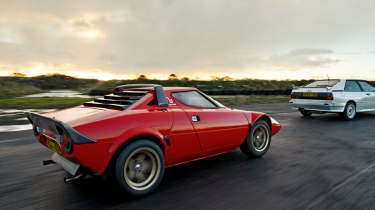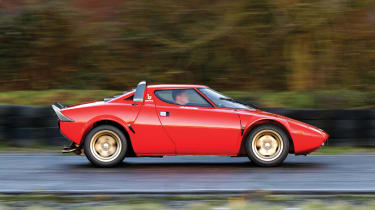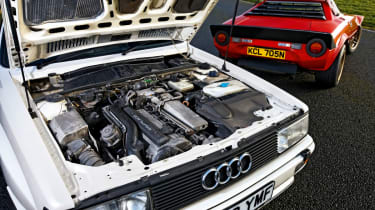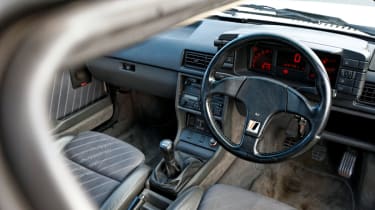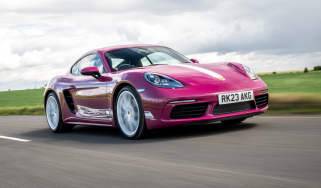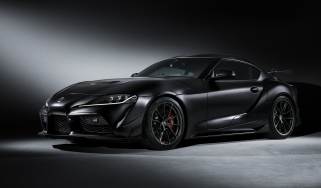Audi Quattro vs Lancia Stratos: Driving the legends
Here are the road versions of the cars that dominated world rallying for almost two decades
It could have come from another planet. The Lancia Stratos is so completely alien to the rest of the automotive world that you have to wonder how Bertone ever dreamt the thing up in the first place. From its wheeled-cheese-wedge profile and helmet-visor windscreen to the detailing and proportions, we’d not seen its anarchic nonconformity before or – until this month – since.
The Audi Quattro is the styling antithesis of the Lancia. At our Hethel-based face-off it stands next to the orangey-red homage to Pythagorus like a giant, muscled breeze-block. Square, bluff, blunt, hard and strong, it looks ready to head-butt a path through the laws of aerodynamics rather than neatly cleaving the air apart with an axe-like wedge. It would be nigh on impossible to find an iconic pairing more different on the eye, and yet not only have both of these machines been reinvented for the second decade of the 21st century, each in their day brought revolution to world rallying and became the dominant force of their time.
The Stratos looks and feels like it was designed for one man – Lancia’s favoured son, Sandro Munari. It was a bespoke rally machine built from the ground up for the Italian to dominate the world scene. Road cars only emerged for homologation purposes, 500 being required for Group 4 eligibility (in fact 492 are thought to have been produced), with the chassis and bodies built by Bertone in Turin between 1973 and 1975. Only final assembly was carried out at Lancia’s Chivasso plant and it was there that they were fitted with the same Ferrari 2.4-litre V6 Dino engine with twin-choke Weber carburettors as the rally machines, only slightly less highly tuned, developing 190bhp at 7000rpm.
More reviews
Group tests
- Ariel Atom 4R v Caterham Seven ‘evo25’: power-to-weight heroes go head-to-head
- Aston Martin Vantage V600 v Aston Martin Vantage GT8 – limited-run Astons go head-to-head
- Aston Martin Vantage vs Audi R8 V10 RWD – back to basics
- BMW E30 M3 v E46 M3 CSL v F87 M2 CS
- BMW M8 Competition Gran Coupe vs Audi RS7 Sportback – battle of the alt-supersaloon
- Caterham Super Seven 600 v Super Seven 2000
- Levante v T1
- Corvette Stingray v Porsche Cayman GTS v Audi R8 RWD
- Great Ferrari hypercars driven: 288 GTO, F40, F50 and Enzo head-to-head
- Hardcore Ferrari V8 specials go head-to-head
In-depth reviews
- Abarth 600e 2024 review – Italian flair in an electric crossover?
- Alpine A110 review – distinctive, lightweight and unforgettable to drive
- Audi RS7 Sportback Performance review
- Bentley Continental R Mulliner: review, history and specs
- BMW X7 review
- Cupra Leon review
Long term tests
- Alfa Romeo Giulia Veloce Fast Fleet test – 7000 miles in the sharp Italian saloon
- Alpina B10: end of term report
- Alpina B10
- Alpina B10
- Alpina B10
- Ford Mustang GT
- Ford Mustang GT
- Ford Mustang GT
- Honda Civic Type R (FK8): living with it
- Land Rover Defender 110 Fast Fleet test – 9000 miles in the go-anywhere SUV
Review
- New Aston Martin DBS 770 Ultimate review – 759bhp super-GT driven
- New Bentley Batur 2023 review – can it possibly be worth £1.65m?
- 2023 Chevrolet Corvette C8 Z06 review – the American 911 GT3?
- Kia EV6 GT-Line S prototype review – the EV that shows how it’s done
- BBR Supercharged Mazda MX-5 (ND) 2023 review – tuned 250bhp roadster driven
- MG4 Trophy 2023 review
Reviews
- Abarth 695 75 Anniversario edition 2024 review – a fitting send-off for Abarth’s hot supermini?
- Abarth 500e 2023 review
- AC Cobra 378 Superblower MkIV 2021 review – another V8 Cobra, but with a GM heart this time
- Acura Integra Type S 2024 review – a Honda Civic Type R with added restraint
- Alfa Romeo Giulia Veloce 2023 review
- Alfa Romeo Giulia GTAm 2021 review – if Porsche built a four-door 911 GT3 RS
- Alfa Romeo SZ: history, review and specs of an icon
In Munari’s hands, the Stratos won the Monte Carlo Rally in 1975, 1976 and 1977 amongst other notable victories, and Munari himself became FIA Cup Champion in 1977 (there was no drivers’ world championship at that time). His overall strike rate of 14 wins from 40 World and European events was mighty, but the car required such a skill level that few others were able to master it. Björn Waldegård was one and he had the temerity to ignore team orders and beat Munari in the 1976 San Remo Rally. He was promptly sacked from the factory team.
There was nothing quite like the sight of a Stratos darting through stages on maximum attack, snapping through the turns with almost no inertia and with unwavering commitment from those drivers who had the skill and reflexes to stay on top of it. If you’ve never seen one in full flight you really ought to take a look on YouTube – though perhaps not just before you’re about to drive one. Poring over the period films certainly heightened my anxiety about driving one of the very few road-going examples left in the UK. Value? Over £200,000.
Swing open the door and you immediately sense the lack of mass – the glassfibre panel almost floats on its hinges revealing the largest door bins I’ve ever seen. They were there to store helmets and navigational notebooks, but the bizarrely curved pockets look perfect for transporting violins. The sill is quite wide, making folding yourself up and dropping into the deep, fawn-coloured bucket seat a little awkward, though, once in, the chair is both comfortable and supportive. The view through the wrap-around windscreen is panoramically brilliant and you are so far towards the middle of the car the driving position is almost as central as a McLaren F1’s. It means you’re very close to the passenger, almost rubbing shoulders – perfect for a navigator to bark instructions, less so for photographer David Shepherd to capture a driving shot. The headroom is fine for my 5ft 10in frame, but the rear view mirror is so close to my right temple in this LHD car the view through the slatted rear screen is permanently in my peripheral vision. It’d be very snug with a helmet on.
The pedals are shuffled to the right because the cabin is pushed so far forward the wheel arch intrudes deep into the cabin. The steering wheel sits on your knees and partially obscures the rev-counter and speedo, which are positioned to the right of the wheel rather than behind it. The flip side of all this ergonomic haphazardness is that you are literally sitting right at the pointy-end of the action, but boy is it intimidating. The flat spats above the front wheels are visible just outside the ‘visor’ screen, allowing you to position the car to the millimetre. Accuracy through the precipitous stages of the Monte Carlo Rally would not have been a problem; finding the confidence and bravado to exploit this thing would have been another matter entirely.
Twist the key and the V6 wakes with a metallic rasp, the revs flying with every throttle blip, the engine reverberating just behind your shoulder blades. It’s not overly loud, nor particularly exotic – in fact it’s a sound-stage that will be familiar to anyone who has driven a Clio V6, and, as we’ll discover shortly, this is entirely appropriate because the dynamics are also broadly similar to those of the chunky mid-engined Renault.
The wood-topped gear lever is a full arm- stretch away, with first gear on a dogleg. It’s not a gearbox to be rushed and it has a long throw too, but there’s plenty of torque so you don’t need to constantly swap cogs to make progress. The Lotus test track in mid-December isn’t exactly conducive to fast laps in a car with a reputation for difficult handling – it’s zero degrees and the tarmac is partly damp, partly coated with ice. The good news is the directness of the steering and a decent amount of feel. Turn the wheel and the car reacts instantly – the direction changes are ridiculously sharp, like a fighter jet that’s deliberately designed to be unstable to allow harder and faster manoeuvring. Not only are the track and wheelbase almost square, the Stratos is the only rear-wheel-drive car where the driven wheels toe out (i.e. point away from the centre of the vehicle), so it’s ready to turn in way before you get to a corner. When you do there’s no slack, no delay, and no progression either, just an instantly altered course.
On-the-limit cornering is not something to be toyed with, but if you can summon the courage to push you’ll discover that the front tyres relinquish grip first. Back off and it’ll come back abruptly into line, but keep the throttle on and the rear will cut loose. Balance the throttle and it’ll hang there for a moment while you get busy with the wheel – there are three and a quarter turns lock-to-lock so there’s plenty of twirling to be done. Get it right and it’ll all come back into line. Lose your bottle and back off sharply, or pick up the throttle a fraction too much and it’ll pirouette within its length.
You can feel the mass pitching as the throttle attitude alters. There’s a little roll, but then the Stratos soaks up the deliberately rough sections of the Hethel test track, just as you’d expect from a rally car. With 190bhp it’s not ultra-fast in a modern sense, but there are few cars than can match the Stratos for intensity.
The Quattro doesn’t live on its nerves like that. It gives an impression of invincibility, and that’s exactly what it achieved when it hit the stages in 1981, just as the Stratos was reaching the end of its career. The Quattro wasn’t a bespoke rally machine, though its potential was obvious to the development team and motorsport quickly became the key marketing strategy. Hannu Mikkola was in the middle of a lucrative Ford contract in 1979, but after a short test in one of the prototypes he immediately recognized the advantages the 4x4 system would bring and signed up for 1981 on the spot. Mikkola gave the car its first public outing on the Algarve rally in 1980, when it acted as the course car. Had it been running in the event proper he would have won by 26 minutes!
The Quattro revolutionised rallying. As well as the all-wheel-drive system, the use of a turbocharged in-line five-cylinder engine – with the longitudinal block positioned ahead of the front axle – was equally novel. Forced induction road cars were still very much in their infancy and it was the addition of an intercooler that allowed Audi to productionise a 2.1-litre unit that could develop 200bhp.
It wasn’t perfect – those early road cars suffered from turbo-lag below 3500rpm and the gearbox was a little baulky – but driven to its strengths the Quattro was devastating across country. Meanwhile the rally world had begun its dramatic and dangerous Group B adventure in 1983, but the results kept coming for the Ur-Quattro, with Mikkola winning the drivers’ crown. Following the introduction of the short-wheelbase Sport version in ’84, Audi retained its winning edge, though this time it was another factory driver, Stig Blomqvist, who claimed the title ahead of Mikkola. Most spectacular of all the Sports was the Pikes Peak car with its massive downforce-generating wings (see page 74). In 1987 it was driven up the iconic course with awe-inspiring commitment by Walter Röhrl, who won the event with a new course record.
A Sport homologation special was available for the road, but only 200 were made and they cost twice the price of the standard version. Improved performance for the masses arrived in 1989 with the introduction of the 20V version, now with 220bhp, a wider torque spread and a Torsen diff. Around 1000 were sold, and we’ve got one of them at Hethel.
Sitting inside, it feels far more conventional than the Stratos, although the steering wheel is still offset slightly. The interior is completely unrecognisable from Audis of today: the plastics used for the dash look incredibly cheap and scratchy, while the switchgear feels so delicate you worry about it snapping off in your hands. It all works, though, and while the bright orange digital display is very much of its time, it is also clear and easy to read.
You don’t get the same instant, intense hit as you do in the Lancia. Everything feels conventional, almost dull, after the slightly dangerous edginess and unpredictability of the first run in a Stratos. It’s a slow burner, the Quattro, but after a few laps it starts to release the magic. That resonant five-cylinder warble and turbo hiss accompanies a decent punch from 2500rpm all the way up to the 7000rpm limit, and the mid-range torque makes it possible to amass pace with ease.
Turn the wheel and the reactions are lethargic. Of course, anything would feel like this after the electrifying Stratos, but even after a dozen corners it remains the same. So you have to readjust your driving style. Throw it at a turn and all that weight slung out front over-burdens the tiny 15in wheels. It needs a touch more slowing before you ask it to alter course.
The Audi’s priorities are the polar opposite of the Lancia’s: it’s all about the corner exit rather than the entry and once the initial turn has been made it’s possible to nail the throttle. Hard. Full power can be exploited way before the apex – even in these conditions – and all that gutsy grunt is transferred to the tarmac. Nothing is wasted; the rear squats, the nose assumes a take-off attitude and the Quattro catapults itself out of the turn. It still feels impressive even by today’s standards.
These, then, are two cars that deserve to be re-invented. Neither of the reinterpretations can possibly change our world the way these originals did, but if they can recapture just a smidgeon of their magic in a modern form they should be fêted. After driving this pair I can’t understand why neither has been brought back before. I guess it’s the burden of living up to the extraordinary legacies they left behind.
